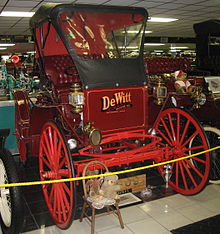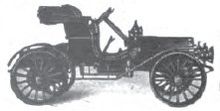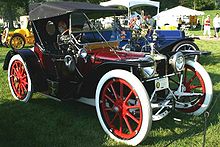Highwheeler



A highwheeler is a usually carriage-like , motor-driven vehicle that was only common in the USA before and around the turn of the 19th and 20th centuries. It is named after its huge wooden spoke wheels. Most highwheelers were powered by a gasoline engine, but there were hardly any technical problems with using an electric motor or a steam engine instead. The robust construction and the good use of space even accommodated the latter. The term highwheeler was not used in Europe.
Concept and advent
The highwheeler was a vehicle for rural America. With a deliberately simple design, it competed successfully with the wagon for a short time thanks to its versatility .
It had to have properties that were predetermined by the huge and poorly developed country. Versatility, a low price, a robust construction and a simple technology that could be mastered without in-depth mechanical knowledge were important. If necessary, repairs had to be carried out quickly on site. If the owner was not able to carry out such repairs himself, this was often done by the local coach builder, wagner or village blacksmith; often this or an innovative drug store took over the local representation for such vehicle brands.
A separate showroom was not required; Usually the dealer used his own vehicle for demonstration purposes - and the new car was delivered by rail in a transport box. All the owner had to do was attach the wheels and fill in fuel, oil and, if water-cooled, well water.
The aforementioned poor development led to the special distinguishing features of the highwheeler , its huge wooden spoke wheels and the very wide track . The wheels came from coach construction and were usually shod with iron. They were intended for the unpaved roads outside of built-up areas and were intended to prevent the vehicle from sinking so deep into the mud that the body of the car hit the ground. With the wide track, the vehicles adapted to the usual cart paths.
Many representatives of this type of vehicle had a seat for the driver and front passenger and an open area for cargo behind it. This could often be protected from the weather with bows on which a tarpaulin was attached. Often a second or even third bench seat could be attached to the loading area. So the whole family could go to church on Sundays or go on an excursion.
Although known far earlier, the highwheeler started a veritable triumphant advance in 1906. Manufacturers shot up like mushrooms; including not only serious but also rather dubious barn businesses. The quality of these products varied accordingly.
Highwheelers typically cost US $ 300 to US $ 400, less than a "real" automobile. From around 1910 onwards, competition arose from the cycle cars . That changed when Henry Ford started lowering the price of his Model T.
construction
The variety among these vehicles is quite large. On the typical highwheeler , both the chassis and the body are made of wood; the former is occasionally armored . Both were very often taken over from wagons or were inspired by their design because the manufacturers were already active in this area and the customers were familiar with them. Often the starting point was a carriage; there were even kits for such a conversion.
In the beginning, many highwheelers had a steam engine and were steered with a lever called "cow's tail", which required a lot of power on wet ground. The steam drive was soon replaced by gasoline engines. Most of these highwheelers had an air-cooled two-cylinder engine built across under the driver's seat - often a boxer - with an output of 10 to 20 bhp (7.6 to 15.2 kW). The force was usually by means of friction gears on a drive shaft and from this via a - rarely two - drive belts, respectively. -transfer chains to the rear axle. One of the best-known high-wheeler manufacturers, the Holsman Automobile Company in Chicago ( Illinois ) initially even made do with two hemp ropes.
Probably the first automobile to be commercially manufactured in the USA, the Duryea from Springfield (Massachusetts) from 1893, was a highwheeler built from a carriage with a friction gear; the brand later also relied on highwheelers .
A typical representative of the simple construction method was the Burns, built from 1908 to 1912 . Their manufacturers, three brothers from Havre de Grace ( Maryland ) and long-established local coach builders, added the obligatory air-cooled two-cylinder engine and power transmission by means of friction gears and double chains to their products on request.
How easy it was to build such vehicles is shown by the example of the food retailer HF Van Wambeke , who lived with his sons in a barn behind his shop at the intersection of Hill and Jefferson Avenue in Elgin (Illinois) between 1907 and 1909 - probably at the request of a customer completed seven or eight highwheelers. Most were delivery vans for the local trade and with air-cooled two-cylinder engines from 10 to 20 hp, typical representatives of their kind. What was untypical was that the Van Wambekes built the engines themselves and used planetary gears; power was transmitted to the rear axle by double chains. They built a four-cylinder for themselves. One or two vehicles were created as runabout passenger cars . There is a photo of such a runabout with a domed bonnet. The van Wambekes asked for US $ 750. They considered building a factory for manufacturing, but wisely chose not to implement this idea.
Later, the steering wheel prevailed over the archaic steering lever and more sophisticated designs appeared. Some - such as the Kearns , the McIntyre , the Pioneer , the Single Center, or the George White - had the engine under a hood at the front and looked like ordinary contemporary automobiles except for the wheels and fenders.
The Pioneer in particular was constructed more elaborately than the typical high wheeler . The vehicle, which was only available as a roadster, was also one of the larger representatives of its class with a wheelbase of 91 in (2,311.4 mm ). The use of a two-cylinder engine was typical; According to the calculation method used at the time, this was one of the more powerful in a high wheeler with 20 hp . The power was transmitted to the rear axle via a two-speed planetary gearbox and cardan shaft .
The George White had a steel chassis instead of armored wood, a front engine and magneto ignition . Here, too, a two-speed planetary gear and a cardan shaft were used; this was also led in a pipe. The class-standard two-cylinder engine was a four-stroke boxer with air cooling of unknown origin and developed 14 bhp (10.4 kW). The Holsman was at the end of his rather long production time from 1902 to 1910, a very mature product; the last models even got four-cylinder engines with 26 bhp (19.4 kW) power. Victor Hugo Bendix (1881–1945), later founder of the Bendix Corporation , realized his own interpretations of Holsman from 1908–1909 with Bendix , Duplex and Yankee . Mainly commercial vehicles emerged. The largest was an enclosed van with a four-cylinder engine, friction transmission, and a payload of 2,400 lb.
Despite the rather local orientation of the highwheeler production, there was definitely competitive pressure among the manufacturers. The Success Auto-Buggy Manufacturing Company in St. Louis (Missouri) , whose owner was a patent attorney, was probably more successful in issuing licenses for individual components than with its own, thoroughly conventional highwheelers . , Determined by their alleged patent violations resulted in the industry highly publicized processes against the Economy Motor Car Company in Fort Wayne and the WH Kiblinger Company in Auburn (both in Indiana ). A verdict was unlikely to have come about, however, because Success went bankrupt in 1909 and Kiblinger had previously reorganized as the WH McIntyre Company because of this court case . The company was a forerunner of the well-known Auburn Automobile Company .
Additional benefit
Only a few manufacturers built highwheelers for pleasure rides and leisure. The early customers included country doctors, who increasingly traded their horse buggy for high-wheelers.
Most providers emphasized the dual benefits of commercial or agricultural use. Some concentrated more or less on commercial vehicles, such as International Harvester (IHC), where only a few purely passenger cars were built, or Kiblinger and its successor, the McIntyre .
An unexpected additional benefit presented itself when the farmer removed a drive wheel in the field or in the barn and used the engine power from the axle shaft to operate machines or devices, such as a wood saw, water pump, juicer, grain mill or other.
Decline

Highwheelers were most widespread between 1907 and 1912. It is estimated that around 70 manufacturers exclusively or partially carried such vehicles in their range. 20 companies that offered at least one highwheeler were domiciled in Chicago (Illinois) . Highwheelers were often clumsy, clumsy and underpowered, but above all, remarkably uncomfortable. From around 1908, "normal" automobiles were offered at competitive prices, replacing the high-wheeler . It began with his Oldsmobile with the Oldsmobile Curved Dash , the only US $ 650 cost throughout its construction period (1901-1907), and the Rambler of the Thomas B. Jeffery Company , followed by the Ford Model A .
The Ford Model T introduced in 1907 had a restrained sales start, and the overwhelming success of this car, which soon began due to Henry Ford's unique pricing policy , changed the structure of the industry lastingly. Not only the mostly small manufacturers of highwheelers and cycle cars (but these in particular) suffered as a result. After 1910, most manufacturers of such vehicles had to give up if they had not switched production in time; the Ford Model T implemented the necessary properties better and more cheaply than these sometimes primitive vehicles had ever been able to do.
In 1910 Ford was charging US $ 900 for a two-seat Model T Runabout and US $ 950 for the four-seat Touring. That was about three times the price of a high wheeler . In 1911 these prices were already at US $ 680 respectively. US $ 780 fell, in 1912 to US $ 590 resp. US $ 690 and 1913 to US $ 525 respectively. US $ 600. And prices not only stayed low, they kept falling. At the end of 1916 a touring still cost US $ 360. But by then most manufacturers of highwheelers and cycle cars had long since given up or concentrated on another market segment - and a whole range of conventional car manufacturers had followed suit.
Demarcation
Oversized wheels are not a unique selling point for highwheelers . The underslung constructions that were emerging around this time had the same . The first and best-known vehicle of this type was the American Underslung of the American Motor Car Company in Indianapolis ( Indiana ). It originated in 1907 from the idea of chief engineer Fred I. Tone to improve road holding by mounting a conventional chassis upside down. This enabled a lower center of gravity, but the axles that were now above the chassis instead of under the chassis required custom-made wheels. According to the factory, these vehicles can also handle a side tilt of 55 ° without tipping over.
High Wheeler in Underslung- construction are not known.
One of the few European manufacturers of highwheelers - without naming its products that way - was the Swedish Åtvidabergs Vagnfabrik , which did not produce any significant production figures between 1910 and 1912.
literature
- Beverly Rae Kimes (ed.), Henry Austin Clark Jr.: Standard Catalog of American Cars 1805-1942. 3. Edition. Krause Publications, Iola WI 1996, ISBN 0-87341-428-4
- The Automobile of 1904. In: Frank Leslie's Popular Monthly. January 1904, Americana Review, Scotia NY (USA). (also covers imports to the USA)
- Beverly Rae Kimes: Pioneers, Engineers, and Scoundrels: The Dawn of the Automobile in America. Published by SAE (Society of Automotive Engineers) Permissions, Warrendale PA 2005, ISBN 0-7680-1431-X
- Murray Fahnestock: Remember the CINO, Cincinnati built Car? In: The Post & Times Star. Cincinnati, Ohio, December 20, 1961. Mentioned Acorn, Armle (n) of Trucks, Auto Buggy, Buggycar, Cincinnati Steam (1903), Cino, Crane & Breed Ambulances (and Undertakers), C. & B., Enger, Ohio, Powercar, Sayers & Scovill, Schacht, US Truck
- GN Georgano (Ed.), G. Marshall Naul: Complete Encyclopedia of Commercial Vehicles ; MBI Motor Books International, Osceola WI (1979); ISBN 0-87341-024-6
- Albert Mroz: Illustrated Encyclopedia of American Trucks and Commercial Vehicles ; Krause Publications, Iola WI (1996); ISBN 0-87341-368-7 ; ISBN 978-0-87341-368-8
- Albert Mroz: American Cars, Trucks and Motorcycles of World War I: Illustrated Histories of 224 Manufacturers (2009), Mcfarland & Company, Inc., Publishers, Jefferson NC; ISBN 0-78643-967-X ISBN 978-0-78643-967-6
Web links
- earlyamericanautomobiles.com on early automotive history in the USA ( Memento from December 16, 2013 in the Internet Archive ) (English)
- trombinoscar.com; a website with many early US automobiles (French)
- american-automobiles.com: Babcock (English)
- american-automobiles.com: Success (English)
- stltikn.com has pictures of an International Harvester (1913)
- forums.aaca.org: Schacht High wheeler owners (English)
- hemmings.com: Historic High wheeler (English)
- youtube.com: 1908 International Harvester Highwheeler starting (English)
- conceptcarz.com: American Underslung Model 50 (English)
- trombinoscar.com: American Underslung Model 50 (English)
Individual evidence
- ^ Kimes: Pioneers, Engineers, and Scoundrels (Hardcover), p. 217
- ↑ a b Kimes: Pioneers, Engineers, and Scoundrels (Hardcover), p. 219
- ^ Kimes / Clark: Standard Catalog of American Cars 1805-1942 (1985), p. 46
- ^ Kimes: Pioneers, Engineers, and Scoundrels (2005), p. 218
- ^ Kimes / Clark: Standard Catalog of American Cars 1805-1942 (1996), p. 195
- ↑ a b c d Kimes / Clark: Standard Catalog of American Cars 1805-1942 (1996), p. 1493
- ^ A b Mroz: Ill. Encyclopedia of American Trucks and Commercial Vehicles (1996), p. 392
- ↑ a b american-automobiles.com: George White Buggy Co.
- ↑ Harald H. Linz, Halwart Schrader : The International Automobile Encyclopedia . United Soft Media Verlag, Munich 2008, ISBN 978-3-8032-9876-8 .
- ↑ Georgiano / Naul: Complete Encyclopedia of Commercial Vehicles (1979) 82
- ↑ Kimes / Clark: Standard Catalog of American Cars 1805-1942 (1996), p. 1448
- ↑ Kimes: Pioneers, Engineers, and Scoundrels (Hardcover), pp. 213-214
- ^ Kimes / Clark: Standard Catalog of American Cars 1805-1942 (1996), p. 805
- ↑ Kimes / Clark: Standard Catalog of American Cars 1805-1942 (1996), pp. 953-954
- ↑ earlyamericanautomobiles.com: Babcock
- ↑ Kimes / Clark: Standard Catalog of American Cars 1805-1942 (1996), p. 1383 (Aldo)
- ^ Kimes / Clark: Standard Catalog of American Cars 1805-1942 (1996), p. 576
- ↑ Kimes / Clark: Standard Catalog of American Cars 1805-1942 (1996), p. 577
- ^ Kimes / Clark: Standard Catalog of American Cars 1805-1942 (1996), p. 578
- ↑ Kimes / Clark: Standard Catalog of American Cars 1805-1942 (1996), p. 575
- ↑ Kimes / Clark: Standard Catalog of American Cars 1805-1942 (1996), p. 581
- ↑ conceptcarz.com: American Underslung Model 50
- ↑ trombinoscar.com: American Underslung Model 50




